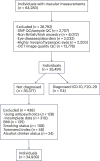Genetic susceptibility to schizophrenia through neuroinflammatory pathways associated with retinal thinness
- PMID: 40365461
- PMCID: PMC12066354
- DOI: 10.1038/s44220-025-00414-6
Genetic susceptibility to schizophrenia through neuroinflammatory pathways associated with retinal thinness
Abstract
Schizophrenia is associated with structural and functional changes in the central nervous system, including the most distal part of it, the retina. However, the question of whether retinal atrophy is present before individuals develop schizophrenia or is a secondary consequence of the disorder remains unanswered. Here we address this question by examining the association between polygenic risk scores for schizophrenia and retinal morphologies in individuals without a schizophrenia diagnosis. We used population data for 34,939 white British and Irish individuals from the UK Biobank. Our robust regression results show that higher polygenic risk scores for schizophrenia were associated with thinner overall maculae, while controlling for confounding factors (b = -0.17, P = 0.018). Similarly, we found that greater polygenic risk scores for schizophrenia specific to neuroinflammation gene sets were associated with thinner ganglion cell inner plexiform layers (b = -0.10, self-contained P = 0.014, competitive P = 0.02). These results provide new evidence for genetic factors that could predispose individuals to heightened neuroinflammatory responses. Over time, these responses could contribute to neurodegenerative processes such as retinal thinning.
Keywords: Diagnostic markers; Genetics research; Schizophrenia.
© The Author(s) 2025.
Conflict of interest statement
Competing interestsP.H. has received grants and honoraria from Novartis, Lundbeck, Mepha, Janssen, Boehringer Ingelheim and Neurolite outside of this work. No other disclosures were reported.
Figures


Update of
-
Genetic susceptibility to schizophrenia through neuroinflammatory pathways is associated with retinal thinning: Findings from the UK-Biobank.medRxiv [Preprint]. 2024 Apr 17:2024.04.05.24305387. doi: 10.1101/2024.04.05.24305387. medRxiv. 2024. Update in: Nat Ment Health. 2025;3(5):538-547. doi: 10.1038/s44220-025-00414-6. PMID: 38633770 Free PMC article. Updated. Preprint.
Similar articles
-
Genetic susceptibility to schizophrenia through neuroinflammatory pathways is associated with retinal thinning: Findings from the UK-Biobank.medRxiv [Preprint]. 2024 Apr 17:2024.04.05.24305387. doi: 10.1101/2024.04.05.24305387. medRxiv. 2024. Update in: Nat Ment Health. 2025;3(5):538-547. doi: 10.1038/s44220-025-00414-6. PMID: 38633770 Free PMC article. Updated. Preprint.
-
Genetic Analysis of Retinal Cell Types in Neuropsychiatric Disorders.JAMA Psychiatry. 2025 Mar 1;82(3):285-295. doi: 10.1001/jamapsychiatry.2024.4230. JAMA Psychiatry. 2025. PMID: 39775833
-
Signature of Altered Retinal Microstructures and Electrophysiology in Schizophrenia Spectrum Disorders Is Associated With Disease Severity and Polygenic Risk.Biol Psychiatry. 2024 Nov 15;96(10):792-803. doi: 10.1016/j.biopsych.2024.04.014. Epub 2024 Apr 27. Biol Psychiatry. 2024. PMID: 38679358
-
Optical coherence tomography as retinal imaging biomarker of neuroinflammation/neurodegeneration in systemic disorders in adults and children.Eye (Lond). 2023 Feb;37(2):203-219. doi: 10.1038/s41433-022-02056-9. Epub 2022 Apr 15. Eye (Lond). 2023. PMID: 35428871 Free PMC article. Review.
-
[Optical Coherence Tomography in Disorders of the Central Nervous System].Klin Monbl Augenheilkd. 2018 Nov;235(11):1242-1258. doi: 10.1055/a-0715-7961. Epub 2018 Nov 20. Klin Monbl Augenheilkd. 2018. PMID: 30458564 Review. German.
References
-
- London, A., Benhar, I. & Schwartz, M. The retina as a window to the brain—from eye research to CNS disorders. Nat. Rev. Neurol.9, 44–53 (2012). - PubMed
-
- Lee, W. W., Tajunisah, I., Sharmilla, K., Peyman, M. & Subrayan, V. Retinal nerve fiber layer structure abnormalities in schizophrenia and its relationship to disease state: evidence from optical coherence tomography. Invest. Opthalmol. Vis. Sci.54, 7785–7792 (2013). - PubMed
-
- Komatsu, H. et al. Retinal layers and associated clinical factors in schizophrenia spectrum disorders: a systematic review and meta-analysis. Mol. Psychiatry27, 3592–3616 (2022). - PubMed
Grants and funding
LinkOut - more resources
Full Text Sources
